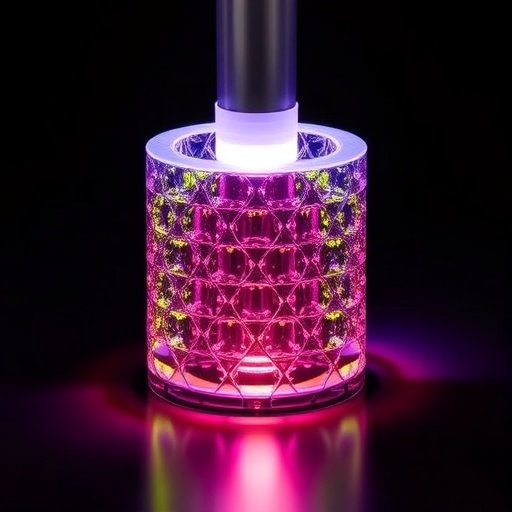In the dynamic field of battery technology, the quest for materials that can provide both high performance and longevity remains a priority. Recent advancements have emerged from a study conducted by researchers Li, Zhang, and Xiao, who have investigated carbon–nitrogen co-doped Na₂FePO₄F cathode materials. These materials present a promising solution, achieving remarkable rate capabilities and extended cycle performance, setting the stage for next-generation energy storage systems.
At the heart of modern energy challenges lies the need for efficient and sustainable battery materials. Lithium-ion batteries, while dominant, have faced criticism over resource scarcity and environmental impact. Sodium-ion batteries, on the other hand, have gained traction as a viable alternative due to the abundance of sodium compared to lithium. The researchers’ focus on Na₂FePO₄F is significant; this compound is not only cost-effective but also aligns perfectly with global sustainability goals by utilizing earth-abundant elements.
The innovative process of carbon and nitrogen co-doping has become a focal point of the researchers’ study. The addition of carbon significantly enhances electronic conductivity, thereby improving the overall electrochemical performance of the cathode material. Simultaneously, nitrogen doping facilitates better structural stability and fosters higher ionic conductivity. This dual-doping strategy exemplifies how careful manipulation of elemental composition can yield materials that exceed traditional performance metrics.
The synthesis of these co-doped materials utilized a solid-state reaction method, a technique favored for its simplicity and efficiency. This approach allows for the precise control of the environment in which the Na₂FePO₄F is formed, paving the way for optimally tuned properties. The process involved careful temperature management to ensure the carbon and nitrogen were effectively incorporated into the lattice structure of the cathode material, a prerequisite for achieving the desired performance outcomes.
One of the standout features of the researchers’ work is the resulting high-rate capability of the co-doped Na₂FePO₄F. This characteristic is critical for applications requiring quick charge and discharge cycles, a demand that is increasingly prevalent in electric vehicles and grid storage applications. Through extensive testing, Li and colleagues demonstrated that the co-doped material maintains a high level of performance even under rapid cycling conditions, showcasing its potential viability in real-world scenarios.
Furthermore, the long cycle life achieved by this material addresses a significant concern in battery technology — degradation over time. Most conventional cathode materials suffer from capacity fading after numerous charge-discharge cycles, leading to shorter battery lifespans. However, the Na₂FePO₄F exhibited enhanced structural integrity and stability, allowing it to withstand extensive cycling without compromising its electrochemical properties. This stability is essential for commercial applications, where reliability is paramount.
An important aspect of their findings lies in the electrochemical characterization of the co-doped materials. The researchers conducted a series of tests to evaluate key performance metrics, including charge-discharge profiles, cycling stability, and rate capabilities. Their results illustrated a marked improvement over previously studied sodium-based cathodes, establishing a new benchmark for performance in this domain.
Moreover, the implications of this research extend beyond just performance metrics. The findings also contribute to a broader understanding of how doping strategies can be applied to other battery materials. The principles behind carbon and nitrogen doping may inspire new studies aimed at enhancing the performance of lithium-ion batteries or other sodium-ion alternatives, leading to a potential revolution in energy storage technologies.
In summary, Li, Zhang, and Xiao’s study not only brings forth a high-performing cathode material but also illustrates the importance of innovative material science in addressing the energy challenges of the future. The ability to harness simple and abundant materials while enhancing their functionalities speaks volumes about the direction of modern research. This work is a testament to the power of interdisciplinary research in driving advancements that align with both technological needs and environmental sustainability.
Looking ahead, the development of carbon–nitrogen co-doped Na₂FePO₄F materials could catalyze a shift in how researchers approach energy storage solutions. As more studies are performed in this vein, it is plausible that a new era of safer, more efficient, and eco-friendly batteries will emerge, ultimately paving the way for widespread adoption and mobilization of clean energy sources in various applications. The future of battery technology thus appears brighter, with this research leading the charge.
Ultimately, this study represents not just incremental progress, but a bold step towards a more sustainable and energy-efficient future. The combination of high rate capabilities and long cycle performance, underpinned by smart material engineering, sets an inspiring precedent for ongoing and future innovations in the realm of energy storage.
Subject of Research: Carbon–nitrogen co-doped Na₂FePO₄F cathode materials
Article Title: Carbon–nitrogen co-doped Na₂FePO₄F cathode material with high rate and long cycle performance
Article References:
Li, Z., Zhang, D., Xiao, D. et al. Carbon–nitrogen co-doped Na2FePO4F cathode material with high rate and long cycle performance.
Ionics (2025). https://doi.org/10.1007/s11581-025-06765-5
Image Credits: AI Generated
DOI: https://doi.org/10.1007/s11581-025-06765-5
Keywords: battery technology, sodium-ion batteries, cathode materials, carbon-doping, nitrogen-doping, energy storage solutions, high rate capability, long cycle performance, electrochemical characteristics, sustainability.
Tags: battery longevity and cycle performancecarbon-nitrogen co-doping techniquesdual-doping strategies in batteriesearth-abundant element utilizationenergy storage systems advancementsenhanced electrochemical performanceenvironmental impact of battery materialshigh-performance sodium-ion batteriesinnovative battery technology solutionsNa2FePO4F cathode materialssodium-ion vs lithium-ion batteriessustainable battery materials research





